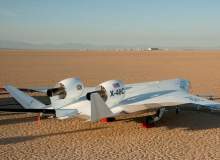
Having completed its flight testing campaign in late April, Boeing’s X-48C experimental aircraft can only be considered a successful first foray into blended wing body (BWB) aircraft. Having been first conceptualised in the 1990s, the BWB finally looks like taking off.
Boeing acquired the concept as part of the company’s merger with McDonnell Douglas in 1997, with the latter’s Project Redwood certain of providing fuel efficiency advantages over traditionally designed aircraft. The concept relies on the aircraft designed as one entire part, combining the fuselage and wings into a more triangular design.
By reducing the number of parts that are pieced together and creating a design that is more streamlined, it is expected that the aircraft will provide greater fuel efficiency through being more aerodynamic.
How well do you really know your competitors?
Access the most comprehensive Company Profiles on the market, powered by GlobalData. Save hours of research. Gain competitive edge.

Thank you!
Your download email will arrive shortly
Not ready to buy yet? Download a free sample
We are confident about the unique quality of our Company Profiles. However, we want you to make the most beneficial decision for your business, so we offer a free sample that you can download by submitting the below form
By GlobalDataIn an age where airliners are increasingly at odds with spiralling fuel prices, any way in which fuel efficiency can be drastically boosted has to be considered worth persevering.
BWB goes into development
Having been developed through a collaboration involving Nasa’s Langley Research Center and Boeing Phantom Works, the aircraft’s initial entity – the X-48B – completed wind tunnel testing in May 2006, before progressing to taxi and ground testing.
Boeing X-48 chief engineer Norman Prince said: "Earlier wind-tunnel testing and the upcoming flight testing are focused on learning more about the BWB’s low-speed flight-control characteristics, especially during takeoffs and landings. Knowing how accurately our models predict these characteristics is an important step in the further development of this concept."
The X-48B first flew in July 2007, reaching an altitude of 7,500ft during a 31 minute flight, before completing its initial flight testing phase in March 2010. Just over two years later the latest incarnation of the aircraft, the X-48C, commenced flight testing.
Featuring a new flight computer, new engines and a slight re-design, which saw the vertical stabilisers moved inboard, the aircraft completed 30 further test flights, finishing in April 2013.
The future for BWB aircraft
With two successful flight test regimes under its belt, the X-48 programme is edging ever closer towards proving the BWB concept as a manageable, fuel-efficient alternative to fuselage-and-wing aircraft.
Boeing and Nasa now intend to developer a larger BWB capable of transonic flight based upon the X-48C concept.
BWB aircraft are now also interesting the US Army and Air Force, with their improved fuel efficiency likely to be highly applicable for air-to-air refueling and cargo delivery missions.
Thought to be between 15 and 20 years away from development, blended wing body aircraft could become a cornerstone of not just civilian airliners, but non-combat military aircraft too.
Related content
Getting to grips with graphene: aviation’s revolution?
Graphene, the multipurpose miracle material first manufactured at Manchester University, has been vaunted as potentially revolutionary for the aviation industry.
ADS-B: aircraft surveillance at the top of the world
With its enhanced capabilities and low cost, next-generation ADS-B aircraft surveillance technology is becoming an aviation industry standard. But what are the challenges and benefits of implementing ADS-B in the world’s more remote regions?



